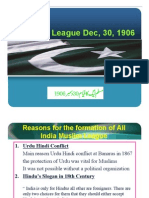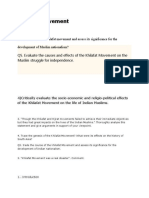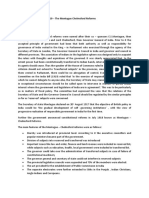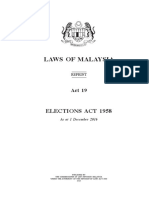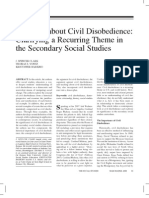The Third June Plan
The Third June Plan
Uploaded by
TheWriters LarkanaCopyright:
Available Formats
The Third June Plan
The Third June Plan
Uploaded by
TheWriters LarkanaOriginal Description:
Copyright
Available Formats
Share this document
Did you find this document useful?
Is this content inappropriate?
Copyright:
Available Formats
The Third June Plan
The Third June Plan
Uploaded by
TheWriters LarkanaCopyright:
Available Formats
The Third June Plan:
Outline:
• Background
• Approval Of The 3rd June Plan
• Main Features Of The 3rd June Plan
• Implementation Of The Plan
Background:
Lord Mountbatten had been appointed as the last Viceroy of India who was to replace Lord Wavell. He
arrived in India on 22nd March, 1947. He came charged with the task to make a peaceful transfer of power
from British to Indian hands by June, 1948.
Approval Of The 3rd June Plan:
Lord Mountbatten soon began negotiation with the political leaders of India. After prolonged talks,
Mountbatten worked out a partition plan by middle of April, 1947. Then on 2nd May 1947, he sent that plan
to England for approval. The British Government approved the plan with certain amendments and sent it back
to India on 10th May, 1947. This draft was not accepted by Nehru and other Congress leaders. Thus at the
request of the Viceroy, Nehru and Memon prepared a revised partition plan which suited their interests.
Mountbatten took that plan to England and at the threat of his resignation got it approved by the British
Cabinet. He returned back to India on 31st May, 1947. The partition plan was made public on 3rd June, 1947
and is known as 3rd June Plan.
Main Features Of The 3rd June Plan:
Following were the main features of the plan.
i) The legislatures of Punjab and Bengal shall decide that whether the provinces should be divided or not.
ii) The Indian people shall make the constitution of India. This constitution shall not be applicable to those
areas whose people reject it.
iii) Referendum shall be held in NWFP.
iv) The province of Baluchistan shall adopt a proper way to decide its future.
v) States shall be free and independent to join one or the other country. Both countries shall have their own
Governor-General who will be the Executive Head of their respective countries.
vi) A boundary commission shall be set up to demarcate the boundaries of the two countries.
vii) Military assets shall be divided between the two countries after the partition.
Implementation Of The 3rd June Plan:
The 3rd June Plan was implemented as under.
i) Punjab Province:
The Legislative Assembly of Punjab decided by 91 to 27 votes to join the new constituent assembly. Thus, the
Punjab province was partitioned and the West Punjab joined the new assembly.
ii) Bengal Province:
Bengal province decided by 106 to91 votes to join new constitutional assembly and the East Bengal joined
Pakistan.
iii) Sindh Province:
Sindh Legislative Assembly decided by 30 to 20 votes in favour of Pakistan.
iv) NWFP Province:
In NWFP, a referendum was held, in which 2, 89, 24 votes were cast in favour of Pakistan and 2, 874 against
Pakistan.
v) Baluchistan Province:
In Baluchistan, the members of Shahi Jirga and the Municipality of Quetta decided in favour of new
constituent assembly.
You might also like
- Nehru ReportDocument3 pagesNehru Reportpari100% (4)
- Roy vs. HerbosaDocument4 pagesRoy vs. HerbosaAnn Mutya MapanoNo ratings yet
- 3rd June PlanDocument3 pages3rd June Plansabir17100% (3)
- 3rd June PlanDocument3 pages3rd June Plansabir1793% (15)
- Maori Sovereignty in The 21st Century - Lecture of MapiriaDocument16 pagesMaori Sovereignty in The 21st Century - Lecture of MapiriaShane-Charles Wenzel100% (5)
- Law277.Lecture 1Document2 pagesLaw277.Lecture 1Syafiqah CkNo ratings yet
- Cabinet MissionDocument5 pagesCabinet Missionjawad hanif100% (1)
- 3 June Plan (1947) : Raj Muhammad KhanDocument9 pages3 June Plan (1947) : Raj Muhammad KhanAbbas Babar100% (1)
- All India Muslim LeagueDocument23 pagesAll India Muslim LeagueMalik Ammar Asad93% (14)
- 1937 ElectionsDocument13 pages1937 ElectionsHamza Khan100% (1)
- CSS/PMS ANSWERS On Khilafat MovementDocument66 pagesCSS/PMS ANSWERS On Khilafat MovementSayed Adnan ShahNo ratings yet
- All India Muslim LeagueDocument3 pagesAll India Muslim Leaguejaved rashidNo ratings yet
- Lahore Resolution AssignmentDocument3 pagesLahore Resolution AssignmentMark Manson100% (2)
- Initial Problems of PakistanDocument3 pagesInitial Problems of PakistanRimsha100% (1)
- The Radcliffe Award PDFDocument7 pagesThe Radcliffe Award PDFAshwath SitaramanNo ratings yet
- UPSC Civil Services Examination: UPSC Notes (GS-I) Topic: Wavell Plan and Shimla Conference (NCERT Notes)Document2 pagesUPSC Civil Services Examination: UPSC Notes (GS-I) Topic: Wavell Plan and Shimla Conference (NCERT Notes)Momina B KhanNo ratings yet
- Pakistan Movement 1940 To 1947Document8 pagesPakistan Movement 1940 To 1947KARIMA IFTIKHAR100% (2)
- Initial Problems of Pakistan 1947 48 2 PDFDocument7 pagesInitial Problems of Pakistan 1947 48 2 PDFobaidNo ratings yet
- The Congress MinistriesDocument4 pagesThe Congress Ministriessabir1770% (10)
- HIS103, L-7, Lahore Resolution (1940)Document17 pagesHIS103, L-7, Lahore Resolution (1940)Samiun Mazumder Chayan100% (1)
- 7-Simon Commission (1927)Document2 pages7-Simon Commission (1927)fahadraja7880% (5)
- Government of India Act 1919 - The Montague Chelmsford Reforms History IIDocument2 pagesGovernment of India Act 1919 - The Montague Chelmsford Reforms History IIDinesh Gadkari100% (1)
- The Lahore Resolution, 1940 - Pakistan Affairs Notes For CSS - PMSDocument3 pagesThe Lahore Resolution, 1940 - Pakistan Affairs Notes For CSS - PMSSajjad Ahmed Mughal100% (3)
- All India Muslim LeagueDocument2 pagesAll India Muslim LeagueTayyab Tariq100% (1)
- All India Muslim LeagueDocument1 pageAll India Muslim LeagueNoman TariqNo ratings yet
- Partition of BengalDocument8 pagesPartition of BengalAhmadNo ratings yet
- Assignment: Lucknow PactDocument5 pagesAssignment: Lucknow PactSibghaNo ratings yet
- Nehru Report 1928 & Jinnah 14 PointsDocument26 pagesNehru Report 1928 & Jinnah 14 PointsAbbas BabarNo ratings yet
- The Cabinet Mission PlanDocument13 pagesThe Cabinet Mission PlanHamad DilawariNo ratings yet
- The Role of All India Muslim League in PakistanDocument6 pagesThe Role of All India Muslim League in PakistanMahamIsmailNo ratings yet
- Pakistan MovementDocument8 pagesPakistan MovementsaadNo ratings yet
- Lecture 6 - Partition of Bengal, Its Annulment and Its Impact On Hindu-Muslim RelationsDocument20 pagesLecture 6 - Partition of Bengal, Its Annulment and Its Impact On Hindu-Muslim RelationsSazzad Hossain SakibNo ratings yet
- Simla Deputation 1Document5 pagesSimla Deputation 1AdeeKhan100% (1)
- Shimla DeputationDocument2 pagesShimla DeputationAleeha Ilyas50% (2)
- Lahore Resolution 1940Document2 pagesLahore Resolution 1940MZCHOHAN100% (1)
- A Solution To The Problems Facing The Sub-Continent in The Years 1940-1947Document10 pagesA Solution To The Problems Facing The Sub-Continent in The Years 1940-1947abdullah khalilNo ratings yet
- Separation of East PakistanDocument4 pagesSeparation of East PakistanMuhammad Bilal Shah100% (1)
- Congress MinistriesDocument9 pagesCongress Ministriesahsan100% (1)
- Cripps Mission 1942Document3 pagesCripps Mission 1942sabir17100% (3)
- Pakistan Resolution and Cripps MissionDocument14 pagesPakistan Resolution and Cripps MissionMehvish ShoaibNo ratings yet
- The Congress Ministries - Policies Towards MuslimsDocument5 pagesThe Congress Ministries - Policies Towards MuslimsJazmineNo ratings yet
- 6 - Delhi Muslim Proposal - 1927Document1 page6 - Delhi Muslim Proposal - 1927fahadraja7889% (9)
- Hist Topic 23 General Elections 1945 1946 Plan 2 PDFDocument5 pagesHist Topic 23 General Elections 1945 1946 Plan 2 PDFabubakarNo ratings yet
- Radcliffe AwardDocument2 pagesRadcliffe AwardMarhaba Shah100% (1)
- ALLAMA IQBAL's Presidential Address December 1930Document3 pagesALLAMA IQBAL's Presidential Address December 1930Mohd MuneerNo ratings yet
- Creation of Pakistan and Role of Quaid-e-Azam (Dr. Atif Aftab)Document19 pagesCreation of Pakistan and Role of Quaid-e-Azam (Dr. Atif Aftab)abdul waleedNo ratings yet
- Objectives of Establishment of PakistanDocument6 pagesObjectives of Establishment of PakistanKhan Ume Salma Danish100% (2)
- Quaid e Azam Muslim NationalistDocument14 pagesQuaid e Azam Muslim Nationalistprince12No ratings yet
- The Lucknow Pact 1916Document11 pagesThe Lucknow Pact 1916House of knowledge100% (1)
- Radcliff Award 1947Document4 pagesRadcliff Award 1947Moin Satti100% (1)
- Sir Syed Ahmed KhanDocument22 pagesSir Syed Ahmed Khanprince12No ratings yet
- PST 02 Political and Constitutional Phases 1958-1971Document2 pagesPST 02 Political and Constitutional Phases 1958-1971khanxoxo11550% (2)
- Khilafat MovementDocument12 pagesKhilafat MovementOomer Jaam83% (6)
- HIST TOPIC 25 Early Years 1947 To 1958 PDFDocument3 pagesHIST TOPIC 25 Early Years 1947 To 1958 PDFabubakar100% (1)
- Ideology of Pakistan and Quaid-e-AzamDocument2 pagesIdeology of Pakistan and Quaid-e-AzamCss Pursuer0% (1)
- The Communal Award 1932Document1 pageThe Communal Award 1932Muhammad HabibNo ratings yet
- Role of Communalism and Religious DiffernceDocument4 pagesRole of Communalism and Religious Differncerabia doll100% (1)
- 3rd June PlanDocument2 pages3rd June PlanNoreen ImranNo ratings yet
- Pre June 3rd PlanDocument4 pagesPre June 3rd PlanAS IFNo ratings yet
- Purpose of Cabinet MissionDocument9 pagesPurpose of Cabinet Missionwahabnadeem974No ratings yet
- Independence & Partition of India: Shashank Grade:10Document34 pagesIndependence & Partition of India: Shashank Grade:10vijayashankar02100% (1)
- g3rd June PlanDocument20 pagesg3rd June PlanKjsiddiqui BablooNo ratings yet
- Cbjesscq 36Document6 pagesCbjesscq 36Mitanshu100% (1)
- Federalism: 3rd Tier: 1st TierDocument7 pagesFederalism: 3rd Tier: 1st TierSahil Affriya YadavNo ratings yet
- Source of Indonesian LawDocument11 pagesSource of Indonesian LawLegnaNo ratings yet
- Peneyra-v-IAC-MargalloDocument2 pagesPeneyra-v-IAC-MargalloRobby DelgadoNo ratings yet
- Case Digest Phil Blooming Mills Employees V Phil Blooming MillsDocument3 pagesCase Digest Phil Blooming Mills Employees V Phil Blooming MillsQuake G.100% (2)
- Elections Act 1958 (Updated 2016)Document24 pagesElections Act 1958 (Updated 2016)Anonymous CNCH4PkvNo ratings yet
- Parliamentary Procedure - Quick Questions and Answers: T L C W S UDocument4 pagesParliamentary Procedure - Quick Questions and Answers: T L C W S UdeepashajiNo ratings yet
- Teaching About Civil DisobedienceDocument7 pagesTeaching About Civil DisobedienceSorin DumitrașcuNo ratings yet
- 008 Typoco Vs ComelecDocument40 pages008 Typoco Vs ComelecRonald MorenoNo ratings yet
- Criminal Law 01Document48 pagesCriminal Law 01Ballentos, Paul Jeffrey100% (1)
- Reyno C. Dimson vs. Gerry T. ChuaDocument2 pagesReyno C. Dimson vs. Gerry T. ChuaGlenn Rey D. AninoNo ratings yet
- Union LegislatureDocument41 pagesUnion LegislatureTribhuwan PantNo ratings yet
- Hill v. United States, 149 U.S. 593 (1893)Document11 pagesHill v. United States, 149 U.S. 593 (1893)Scribd Government DocsNo ratings yet
- Freedom and Human RightsDocument25 pagesFreedom and Human RightsRutchel Hechanova-EspinosaNo ratings yet
- Federal Energy Administration Et Al. v. Algonquin SNG, Inc., Et Al.Document4 pagesFederal Energy Administration Et Al. v. Algonquin SNG, Inc., Et Al.Maria AnalynNo ratings yet
- R209292y@students Msu Ac ZWDocument7 pagesR209292y@students Msu Ac ZWColias DubeNo ratings yet
- Motion For Leave To File BriefDocument35 pagesMotion For Leave To File BriefWDET 101.9 FMNo ratings yet
- Nachura - Notes - Consti 1 and 2Document129 pagesNachura - Notes - Consti 1 and 2Myles Laboria100% (3)
- Marlene Ryder v. Terrence McCabe, 3rd Cir. (2012)Document4 pagesMarlene Ryder v. Terrence McCabe, 3rd Cir. (2012)Scribd Government DocsNo ratings yet
- Special Power Pre-TrialDocument2 pagesSpecial Power Pre-TrialJan-Lawrence OlacoNo ratings yet
- Chua vs. Comelec - 2016Document15 pagesChua vs. Comelec - 2016Yaki RelevoNo ratings yet
- JurisprudenceDocument24 pagesJurisprudenceajay100% (5)
- Confidential: The Facade That Is The IebcDocument13 pagesConfidential: The Facade That Is The IebcCyprian NyakundiNo ratings yet
- MCSThird Amendment Final GazetteDocument15 pagesMCSThird Amendment Final GazetteFrank OpsNo ratings yet
- Kalyan Sir - PreambleDocument9 pagesKalyan Sir - PreambleDhoorjati VommiNo ratings yet
- Almonte Vs Vasquez DigestDocument2 pagesAlmonte Vs Vasquez DigestLennart ReyesNo ratings yet
- Our Duties and Responsibilities As CitizensDocument2 pagesOur Duties and Responsibilities As Citizensjosephine subrosaNo ratings yet








